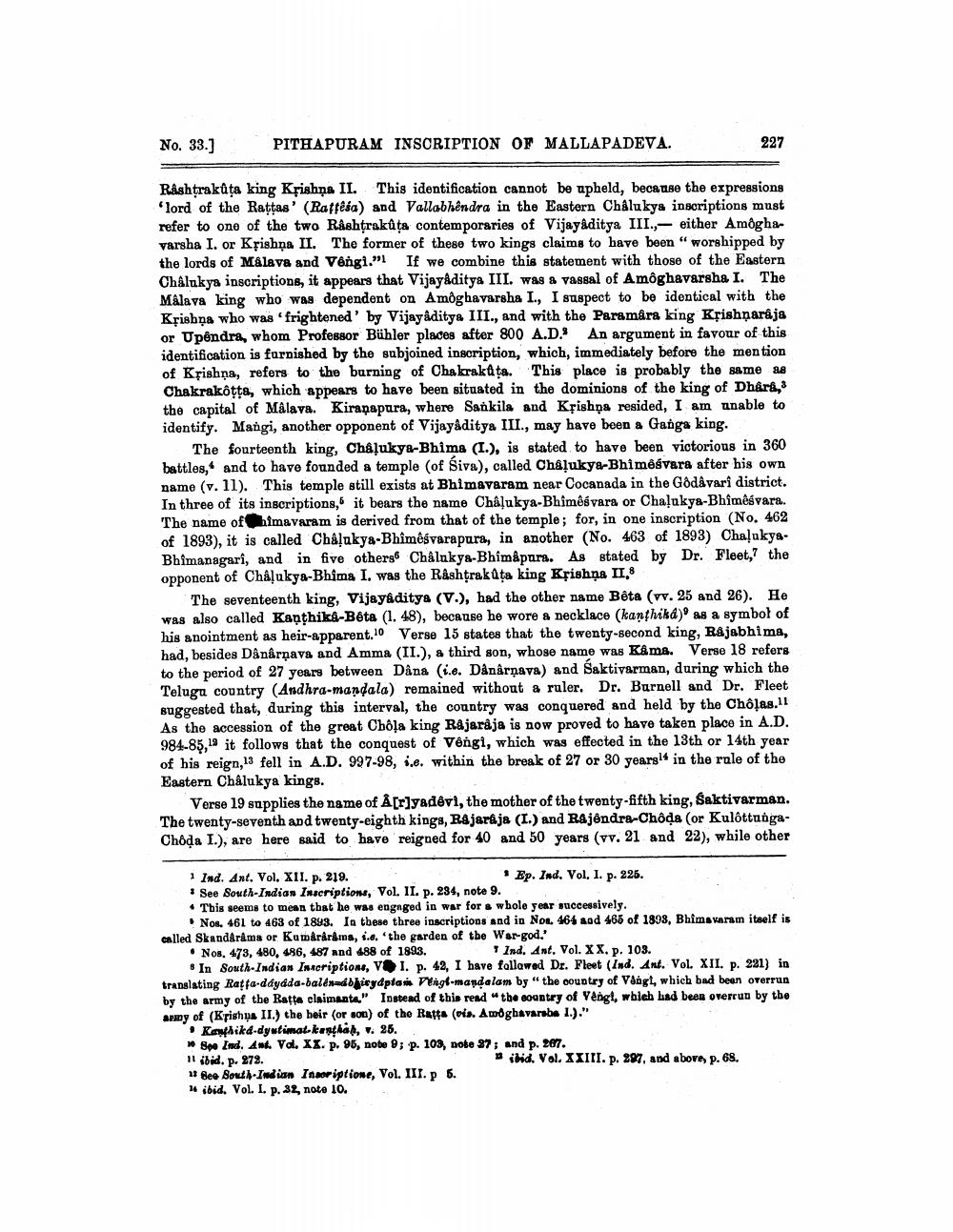________________
No. 33.]
PITHAPURAM INSCRIPTION OF MALLAPADEVA.
227
Rashtrakūta king Krishna II. This identification cannot be upheld, because the expressions
lord of the Rattas' (Raffésa) and Vallabhêndra in the Eastern Chalukya inscriptions must refer to one of the two Råshtrakūta contemporaries of Vijayaditya III., either Amoghavarsha I. or Krishna II. The former of these two kings claims to have been "worshipped by the lords of Málava and Vengi.”! If we combine this statement with those of the Eastern Chalukya inscriptions, it appears that Vijayaditya III. Was & vassal of Amôghavarsha I. The Málava king who was dependent on Amôghavarsha I., I suspect to be identical with the Krishna who was 'frightened' by Vijayaditya III., and with the Paramára king Krishnaraja or Upêndra, whom Professor Bühler places after 800 A.D. An argument in favour of this identification is furnished by the subjoined inscription, which, immediately before the mention of Krishsa, refers to the burning of Chakrakata. This place is probably the same as Chakrakotta, which appears to have been situated in the dominions of the king of Dhari, the capital of Mâlava. Kiranapura, where Sarkila and Kfishộa resided, I am unable to identify. Mangi, another opponent of Vijayaditya III., may have been a Ganga king.
The fourteenth king, Chalukya-Bhima (I.), is stated to have been victorious in 360 battles, and to have founded a temple (of Siva), called Châļukya-Bhimêsvara after his own name (v. 11). This temple still exists at Bhimavaram near Cocanada in the Godavari district. In three of its inscriptions, it bears the name Chalukya-Bhimêsvara or Chalukya-Bhimêsvara. The name of himavaram is derived from that of the temple; for, in one inscription (No. 462 of 1893), it is called Chåļukya-Bhîmêśvarapura, in another (No. 463 of 1893) ChalukyaBhîmanagari, and in five others Châlnky&-Bhimậpara. As stated by Dr. Fleet, the opponent of Chalukya-Bhima I. was the Rashtrakata king Krishna II,8
The seventeenth king, Vijayaditya (V.), had the other name Bêta (vv. 25 and 26). He was also called Kanthika-Béta (1. 48), because he wore & necklace (kanthikd) as a symbol of his anointment as heir-apparent. Verse 15 states that the twenty-second king, Rajabhima, had, besides Dânârnava and Amma (II.), a third son, whose name was Kåma. Verse 18 refers to the period of 27 years between Dâna (i.e. Dånårņava) and Saktivarman, during which the Telugu country (Andhra-mandala) remained without a ruler. Dr. Burnell and Dr. Fleet suggested that, during this interval, the country was conquered and held by the Chôļas.11 As the accession of the great Chola king Rajaraja is now proved to have taken place in A.D. 984-85, it follows that the conquest of Vengi, which was effected in the 13th or 14th year of his reign, 13 fell in A.D. 997-98, s.c. within the break of 27 or 30 years in the role of the Eastern Chalukya kings.
Verse 19 supplies the name of Å[r]yadevi, the mother of the twenty-fifth king, Saktivarman. The twenty-seventh and twenty-eighth kings, R&jarêja (I.) and Rajendra-Chôda (or KulôttungaChoda I.), are here said to have reigned for 40 and 50 years (vv. 21 and 22), while other
1 Ind. Ant. Vol. XII. p. 219.
Ep. Ind. Vol. I. p. 225. • See South Indian Inscriptions, Vol. II. p. 284, note 9. • This seems to mean that he was engaged in war for a whole year successively.
Nos 461 to 463 of 1893. In these three inscriptions and in Nou 464 and 466 of 1898, Bhimavaram itself is called Skandărâma or Kumarårêms, .. the garden of the War-god." • Nos. 473, 480, 486, 487 and 488 of 1893.
1 Ind. Ant. Vol. XX, p. 103. • In South Indian Inscriptions, V I. p. 42, I have followed Dr. Fleet (Ind. An. Vol. XII. p. 221) in translating Ratta-ddydda-balén-dbjicydptania Viage-mandalam by " the country of Vangt, which bad bean overrun by the army of the Ratta claimants." Instead of this read the country of Vengt, which had been overrun by the anny of (Krishna II.) the heir (or son) of the Ratta (vis. Amoghavarba 1.)."
. Katlikd-dyutimal-kenthal, . 25.
Spe Ind. Ank. Vd. XX. p. 96, nobe 9; p. 103, nobe 97; and p. 207. 11 ibid. p. 272.
ibid. Vol. XXIII. p. 297, and above p. 68. 1 Bee South Indian Inscriptione, Vol. III. P 5. 14 ibid. Vol. I. p. 32 note 10.




